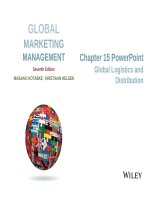Lecture Global marketing management (7th edition): Chapter 16 - Masaaki Kotabe, Kristiaan Helsen
Bạn đang xem bản rút gọn của tài liệu. Xem và tải ngay bản đầy đủ của tài liệu tại đây (3.21 MB, 31 trang )
GLOBAL
MARKETING
MANAGEMENT
Seventh Edition
MASAAKI KOTABKE | KRISTIAAN HELSEN
Chapter 16 PowerPoint
Export and Import
Management
Chapter Overview
1.
2.
3.
4.
5.
6.
7.
8.
Organizing for Exports
Indirect Exporting
Direct Exporting
Mechanics of Exporting
Role of the Government in Promoting Exports
Managing Imports—the Other Side of the Coin
Mechanics of Importing
Gray Markets
Chapter 16
Copyright © 2017 John Wiley & Sons,
Inc.
2
Introduction
• Exporting is the most popular way for many
companies to become international.
• Exporting is usually the first mode of foreign entry
used by companies.
• Selling to foreign markets involves numerous high
risks, arising from a lack of knowledge about and
unfamiliarity with foreign environments, which can
be heterogeneous, sophisticated, and turbulent.
• Furthermore, conducting market research across
national boundaries is more difficult, complex, and
subjective than its domestic counterpart.
Chapter 16
Copyright © 2017 John Wiley & Sons,
Inc.
3
Introduction
• With every export transaction there is an import
transaction.
• Aside from differences between the procedure and
rationale for exports and imports, both are largely
the same the world over
• For successful development of export activities,
systematic collection of information is critical.
Chapter 16
Copyright © 2017 John Wiley & Sons,
Inc.
4
1. Organizing for Exports
• Research for Exports:
First use available secondary data to research
potential markets.
– The identification of an appropriate overseas market
involves the following criteria:
1. Socioeconomic characteristics
2. Political and legal characteristics
3. Consumer variables (e.g., lifestyle, preferences,
culture, taste, purchase behavior, and purchase
frequency)
4. Financial conditions
Chapter 16
Copyright © 2017 John Wiley & Sons,
Inc.
5
1. Organizing for Exports
• It is also to be noted that export research for
markets such as China and the former Soviet
Republics must still be done largely in the field
because their data are often not reliable.
• Export Market Segments
– Homogeneous market segments and clusters
– Geographical and psychographic segments
– Issues of standardization vs. adaptation
Chapter 16
Copyright © 2017 John Wiley & Sons,
Inc.
6
2. Indirect Exporting
• Indirect exporting involves the use of independent
intermediaries or agents to market the firm’s
products overseas.
• Combination Export Manager (CEM)
• Export Merchants
• Export Broker
• Export Commission House
• Trading Companies (sogo shosha)
(See Exhibit 16-1.)
• Piggyback Exporting
Chapter 16
Copyright © 2017 John Wiley & Sons,
Inc.
7
3. Direct Exporting
• Direct exporting occurs when a manufacturer or
exporter sells directly to an importer or buyer
located in a foreign market (Exhibit 16-2).
- Export Department
- Export Sales Subsidiary
- Foreign Sales Branch
Chapter 16
Copyright © 2017 John Wiley & Sons,
Inc.
8
Exhibit 16-1: Comparison of Direct and
Indirect Exporting
Chapter 16
Copyright © 2017 John Wiley & Sons,
Inc.
9
4. Mechanics of Exporting
• The Automated Export System (AES) on the Internet
– In the U.S., the AES was launched in October 1999. It
allows exporters, freight forwarders, and consolidators
to file shippers’ export declaration information in an
automated, cost-free way at all ports.
– AES was incorporated into the Automated
Commercial Environment (ACE) system in 2014.
• Legality of Exports
– Can be proactively dealt with
– Export license (general or validated license)
Chapter 16
Copyright © 2017 John Wiley & Sons,
Inc.
10
Exhibit 16-2: U.S. Government Departments
and Agencies with Export Control
Responsibilities
Chapter 16
Copyright © 2017 John Wiley & Sons,
Inc.
11
4. Mechanics of Exporting
• Export Transactions
– Terms of sale
– Monitoring the transportation and delivery of the
goods to the assigned party
– Shipping and obtaining the bill of lading
• Bill of lading
– A straight bill of lading
– A shipper’s order bill of lading
– Commercial invoice
– Freight forwarders
Chapter 16
Copyright © 2017 John Wiley & Sons,
Inc.
12
4. Mechanics of Exporting
• Terms of Shipment and Sale
– INCOTERMS 2010 (International Commercial Terms)
– Terms of Shipment (Exhibit 16-3):
•
•
•
•
•
•
•
Chapter 16
Ex-Works (EXW) at the point of origin
Free Carrier (FCA)
Carriage Paid To (CPT)
Carriage and Insurance Paid to (CIP)
Delivered at Terminal (DAT)
Delivered at Place (DAP)
Delivered Duty Paid (DDP)
Copyright © 2017 John Wiley & Sons,
Inc.
13
4. Mechanics of Exporting
– Terms of Shipment—Maritime-only Terms (Exhibit 163):
•
•
•
•
Chapter 16
Free Alongside Ship (FAS)
Free on Board (FOB)
Cost and Freight (CFR)
Cost Insurance and Freight (CIF)
Copyright © 2017 John Wiley & Sons,
Inc.
14
Exhibit 16-3: Terms of Shipment
Chapter 16
Copyright © 2017 John Wiley & Sons,
Inc.
15
4. Mechanics of Exporting
• Payment Terms (Exhibit 16-4)
–
–
–
–
–
–
–
Advanced Payment
Confirmed irrevocable letter of credit
Unconfirmed irrevocable letter of credit
Documents Against Payment (D/P)
Documents Against Acceptance (D/A)
Open account
Consignment
• Currency Hedging
– Done through a banker or the firm’s treasury to
counter foreign risk in the export transaction.
Chapter 16
Copyright © 2017 John Wiley & Sons,
Inc.
16
Exhibit 16-4: Terms of Payment in
an Export Transaction
Chapter 16
Copyright © 2017 John Wiley & Sons,
Inc.
17
5. Role of the Government in
Promoting Exports
• Export promotion activities generally comprise:
1. Export service programs
2. Market development programs
• Export Enhancement Act of 1992
• Some governments engage in attracting inward
foreign direct investment (FDI) in the hope their
countries could increase exports (e.g., Argentina)
• Export-Import Bank (Ex-Im Bank)
• Tariff Concessions
– Foreign Trade Zone
Chapter 16
Copyright © 2017 John Wiley & Sons,
Inc.
18
5. Role of the Government in
Promoting Exports
• American Export Trading Company
– The Export Trading Company Act of 1982
• Export Regulations
– The Foreign Corrupt Practices Act (FCPA) of 1977
– U.S. Antitrust Laws
– Tariffs and local laws of foreign governments may
include: tariffs, local laws relating to product
standards and classification, and taxes.
Chapter 16
Copyright © 2017 John Wiley & Sons,
Inc.
19
6. Managing Imports—
the Other Side of the Coin
•
•
•
For organizations in the United States, importing is
considerably easier than for most firms in the rest
of the world.
About 81 percent of the world’s trade is still
denominated in U.S. dollars.
Most of the time, a U.S. importer does not have to
bother with hedging foreign exchange transactions
or with trying to accumulate foreign currency to
pay for imports.
Chapter 16
Copyright © 2017 John Wiley & Sons,
Inc.
20
Exhibit 16-5: Model of Importer Buyer
Behavior
Chapter 16
Copyright © 2017 John Wiley & Sons,
Inc.
21
6. Managing Imports—
the Other Side of the Coin
– Model of Importer Buyer Behavior
Stage 1. Need recognition and problem formulation
(triggered by competition and unavailability)
Stage 2. Search (guided by country characteristics,
vendor characteristics, and information sources)
Stage 3. Choice (vendors evaluation and selection)
Chapter 16
Copyright © 2017 John Wiley & Sons,
Inc.
22
7. Mechanics of Importing
• Steps in Importing
– Finding a bank that either has a branch in the
exporter’s country or has a correspondent bank
– Establishing a letter of credit with the bank
– Deciding on the mode of transfer of goods from
exporter to importer
– Checking compliance with national laws of the
importing country
– Making allowances for foreign exchange fluctuations
– Fixing liability of payment of import transactions and
warehousing
Chapter 16
Copyright © 2017 John Wiley & Sons,
Inc.
23
7. Mechanics of Importing
• Import Documents and Delivery
– Entry documents filed by the consignee:
•
•
•
•
•
•
Entry manifest
Customs form 7533
Customs form 3461
Packing list
Commercial invoice
Also accompanied by evidence that a bond is posted
with customs to cover any potential duties, penalties,
and taxes
– For Special Permit for Immediate Delivery, use
Customs form 3461 for fast release after arrival.
Chapter 16
Copyright © 2017 John Wiley & Sons,
Inc.
24
7. Mechanics of Importing
• Import Duties
–
–
–
–
–
–
Ad valorem duty
Specific duty
Compound duty
Antidumping import duty
Countervailing duty
Duty drawback:
• Direct identification drawback
• Substitution drawback
• All countries have procedures allowing for the
temporary importation of goods for across their borders.
Chapter 16
Copyright © 2017 John Wiley & Sons,
Inc.
25









